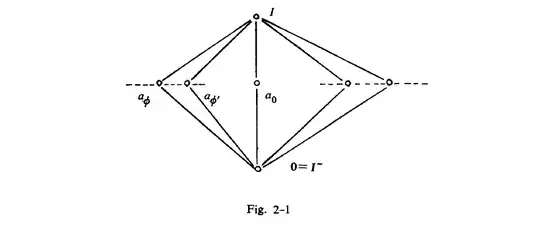I'm trying to understand this highlighted sentence in Piron's "Foundations of Quantum Physics" on p. 21:
I know that distributivity of a lattice means $a\land (b\lor c)=(a\land b)\lor(a\land c)$ and $a\lor (b\land c)=(a\lor b)\land(a\lor c)$. But I don't know what (2.4) and (2.5) has to do with the lattice structure.
On the next page Piron draws this diagram for the lattice:
I also don't understand this. Since $a_\Phi < a_{\Phi\, \text {or} \,\Phi'}$ and $a_\Phi' < a_{\Phi\, \text {or} \,\Phi'}$, we can infer that $a_\Phi\lor a_{\varphi'} < a_{\Phi\, \text {or} \,\Phi'}\neq I$. Isn't it? What am I missing?
Explanation
In (2.4) and (2.5) above, $b$ and $c$ are propositions about a quantum mechanical system. The propositions are the equivalence classes of questions about that system described below.
The logical value of a question depends on the state of the system. By definition, the logical value of the question is true if any experiment performed in this state is affirmative. We introduce a transitive and reflexive relation $<$ between questions $\alpha$ and $\beta$ where $\alpha<\beta$ means that in any state when $a$ is true, $b$ is also true. The questions $\alpha$ and $\beta$ are regarded equivalent if both $\alpha < \beta$ and $\beta<\alpha$ holds. The equivalence classes of questions (the propositions) constitute such a partially ordered set $\mathscr L$ in which any pair of elements $a\in \mathscr L$ and $b\in \mathscr L$ has a least upper bound $a\lor b$ and a greatest lower bound $a\land b$. The structure $(\mathscr L,\lor,\land)$ is a lattice, since $\land$ and $\lor$ are associative, commutative and idempotent and both are absorptive against the other: $a\land (a\lor b)=a$ and $a\lor(a\land b)=a$
My thoughts about this issue
Let $b= the\, polarizer\,with\,angle\, \beta \ always\, \,transmits\, the\, photon$ and $c= the\, polarizer\,with\,angle\, \gamma \ always\, \,transmits\, the\, photon$
The notation in fig 2. would be $b=a_\beta$, $c=a_\gamma$.
Don't forget, $\lor$ desn't mean $or$. It is the lower upper bound of $b$ and $c$. Formulating in words, $b\lor c$ is the proposition "it is always true that the polarizer with angle $\beta$ or the polarizer with angle $\gamma$ transmits the photon. In the superposition state of state belong to $b=true$ and the state belong to $c=true$ , $b = false$, $c = false$ and $b\lor c = true$.
Then taking a proposition $a = true$,
$a\land (b\lor c) = true$ but $(a\land b)\lor (a\land c)=false$
This means the absence of distributivity, so it's OK.
(This is evidently wrong, since $1\land b = b$, $1\land c = c$, so if $a=1$ then $(a\land b)\lor(a\land c)=b\lor c=1\land (b\lor c) = a\land (b\lor c)$. So the non-distributivity is still not clear to me.)
But this contradicts the schema in fig. 2-1.



